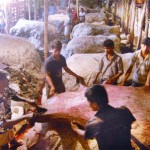 Leather industry people are seen happy this year with increased supply of rawhides at lower prices from the sacrificed animals in Eid-ul-Azha.
Leather industry people are seen happy this year with increased supply of rawhides at lower prices from the sacrificed animals in Eid-ul-Azha.
They estimate that this year the supply would be increased by at least 10 per cent. In the past around 40 per cent of the country’s annual rawhide stocks came from sacrificed animals.
New Age on Monday visited Posta — the country’s largest wholesale centre for rawhide trading — where merchants said that the prices of rawhides were cheaper this year because of increased supply.
‘People spent more this year for sacrificing animal when the prices of stocks were also cheaper on the eve of Eid, increasing the supply of rawhides,’ a Posta merchant Azizur Rahman said.
At, Posta merchants purchased each piece of large-size cowhide (measuring 30-35 feet) at Tk 1000-1200 while medium-sized one for (20-26 feet) at Tk 500-800.
The merchants admitted that the average retail price was down at least 10 per cent compared to that in the previous year.
MA Majed, executive director of the Apex Tannery, the country largest unit for processing hides, said that price of rawhides remained favorable for the industry.
He said about four million pieces of cowhides are available annually in the country with at least 40 per cent of that comes from Eid slaughtering. ‘Availability of hides will be higher this year.’
Rejaul Karim Ansery, president of the Bangladesh Finished Leather, Leather-goods and Footwear Exporters Association said six million plus goats are also slaughtered in Eid while number of slaughtered buffalos and sheep is around two hundred thousand.
Besides the increased supply, prices of rawhide declined because of the campaign of the tanners’ associations that they would not be able to pay much for rawhides as global recession had scaled down volume and value of processed leather at the export markets, said market sources.
Bangladesh major markets of finished leather include Italy, Japan, Germany, France, Korea and China where the demands for leather goods declined due to recessions.
Shahin Ahmed, president of the Bangladesh Tanners Association, however, said that with the signs of global recovery, local exporters were receiving increased purchase orders from the Asian buyers.
Figures from the Export Promotion Bureau show that leather exports amounted to $46 million in the first quarter of the current fiscal, down by about 24 per cent compared to the same period last year.
Footwear exports, however, fell at a moderately low rate—by less than 3 per cent in the first quarter of the current fiscal.




















